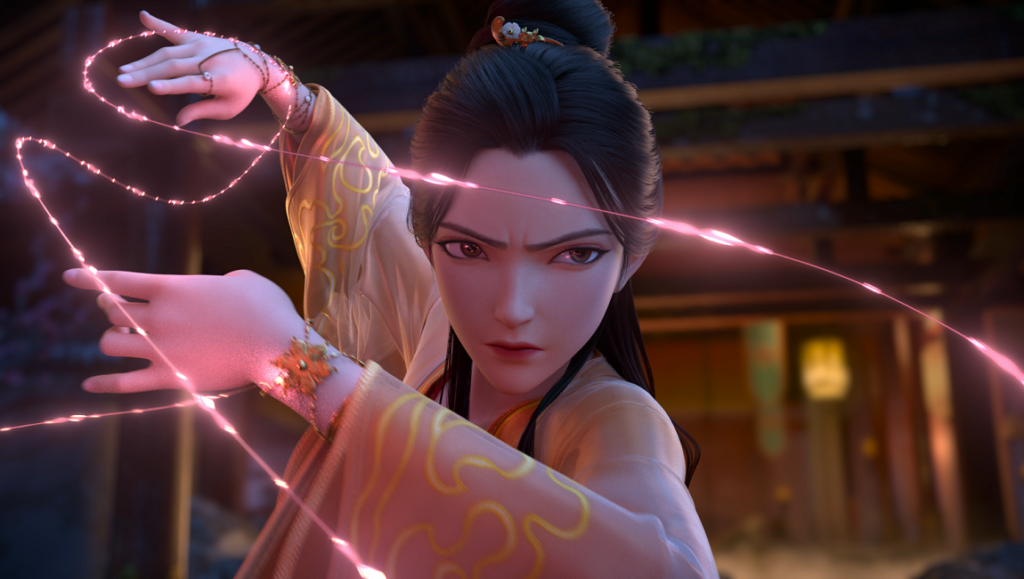The latest film from Light Chaser Animation Studios, New Gods: Yang Jian, continues several ongoing trends in its development as a production house: first, a pivot from original animated features into the more lucrative financial footing of films rooted in ancient Chinese lore; and second, the utilization of this securer thematic base to explore bravura animation techniques and artistry that are frequently stimulating, if not always spellbinding. The rationale is by no means difficult to identify when works such as Monkey King: Hero Is Back (2015) and Big Fish & Begonia (2016) both secured sizable box office returns domestically ($153 million and $79 million, respectively). A renaissance of Chinese animation was signaled and has since been excitedly pursued, with Light Chaser at its forefront. The company — as mentioned above, presumably taking notes from Monkey King’s box office — has released four films in a three-year span (2019-2022) focused entirely on legendary figures: White Snake, Green Snake, Nezha, and Yang Jian. One is left to assume that titles such as Cats and Peachtopia just weren’t connecting with audiences for reasons unknown.
The new era that Light Chaser exemplifies with its recent series is curious: as mentioned, impressive technical productions tied to safe storytelling architecture. This writer’s prior review of Zhao Ji and Amp Wong’s White Snake explores that work in more depth — without the hindsight now available — but where do matters stand now? All in all, not much different. Zhao Ji, now spearheading Light Chaser’s New Gods series, takes on Yang Jian solo, diverging from White Snake with an approach borrowing liberally from Ghibli-esque steam- and cyber-punk designs as well as the moody sci-fi/noir aesthetics of Blade Runner. It’s a peculiar blend, but it makes for interesting viewing — at least for a time, as there is also the plot, of which there’s a lot. Briefly put: Yang Jian’s immortal family is caught in a Daoist cycle of the male side having to imprison the female side in a mountain to stop a Phoenix force from escaping and bringing chaos to the human world — the twist, however, is that this is a tragic trick. There are also bits and pieces about a nephew, a drunken master with a tiger, a mysterious goddess with unclear motivations, a dog who turns into a little girl (or the other way around)… I’ll leave it there for now.
All told, New Gods: Yang Jian is exceedingly competent from a technical standpoint. The animation may veer a little unevenly between principal young characters with no discernible facial features and an almost photo-realistic age afforded elderly ones, resembling at times the video game cutscene a tad too much; but the CGI approach makes the most of its ability to float through and map the film’s geography as needed, and bring to life both its highly impressive action set pieces and deeply idiosyncratic rendering of ancient Chinese mythos — which might find itself hewing as close at times to the Western as it does Star Wars – Episode II: Attack of the Clones (indeed, too, as is common in post-MCU Phase 3 Chinese cinema, Avengers also gets a reference, but this is a comment for another time). As for the screenplay and editing, Yang Jian suffers from the same bloated excess of White Snake, managing to be some twenty minutes longer for no discernible reason. Little drafted in the screenplay — for draft is what it is — dramatically or conceptually justifies a film about a lesser Chinese god clocking in at 127 minutes, regardless of what images are rendered on screen. In sum, for all the advances being made at present in China on the animation front, they are yet to get the story quite straight. This is one for the completists and aficionados of Chinese animation; other viewers may find their time better spent elsewhere.
Published as part of InRO Weekly — Volume 1, Issue 3.


Comments are closed.